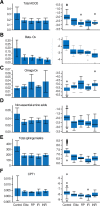Plasma Metabolomics Biosignature According to HIV Stage of Infection, Pace of Disease Progression, Viremia Level and Immunological Response to Treatment
- PMID: 27941971
- PMCID: PMC5152829
- DOI: 10.1371/journal.pone.0161920
Plasma Metabolomics Biosignature According to HIV Stage of Infection, Pace of Disease Progression, Viremia Level and Immunological Response to Treatment
Erratum in
-
Correction: Plasma Metabolomics Biosignature According to HIV Stage of Infection, Pace of Disease Progression, Viremia Level and Immunological Response to Treatment.PLoS One. 2017 Feb 24;12(2):e0173164. doi: 10.1371/journal.pone.0173164. eCollection 2017. PLoS One. 2017. PMID: 28235085 Free PMC article.
Abstract
Background: We evaluated plasma samples HIV-infected individuals with different phenotypic profile among five HIV-infected elite controllers and five rapid progressors after recent HIV infection and one year later and from 10 individuals subjected to antiretroviral therapy, five of whom were immunological non-responders (INR), before and after one year of antiretroviral treatment compared to 175 samples from HIV-negative patients. A targeted quantitative tandem mass spectrometry metabolomics approach was used in order to determine plasma metabolomics biosignature that may relate to HIV infection, pace of HIV disease progression, and immunological response to treatment.
Results: Twenty-five unique metabolites were identified, including five metabolites that could distinguish rapid progressors and INRs at baseline. Severe deregulation in acylcarnitine and sphingomyelin metabolism compatible with mitochondrial deficiencies was observed. β-oxidation and sphingosine-1-phosphate-phosphatase-1 activity were down-regulated, whereas acyl-alkyl-containing phosphatidylcholines and alkylglyceronephosphate synthase levels were elevated in INRs. Evidence that elite controllers harbor an inborn error of metabolism (late-onset multiple acyl-coenzyme A dehydrogenase deficiency [MADD]) was detected.
Conclusions: Blood-based markers from metabolomics show a very high accuracy of discriminating HIV infection between varieties of controls and have the ability to predict rapid disease progression or poor antiretroviral immunological response. These metabolites can be used as biomarkers of HIV natural evolution or treatment response and provide insight into the mechanisms of the disease.
Conflict of interest statement
The authors have declared that no competing interests exist.
Figures




References
-
- Vergis EN, Mellors JW. Natural history of HIV-1 infection. Infect Dis Clin North Am. 2000;14(4):809–25, v-vi. Epub 2001/01/06. - PubMed
-
- Gazzola L, Tincati C, Bellistri GM, Monforte A, Marchetti G. The absence of CD4+ T cell count recovery despite receipt of virologically suppressive highly active antiretroviral therapy: clinical risk, immunological gaps, and therapeutic options. Clin Infect Dis. 2009;48(3):328–37. Epub 2009/01/07. 10.1086/595851 - DOI - PubMed
LinkOut - more resources
Full Text Sources
Other Literature Sources

